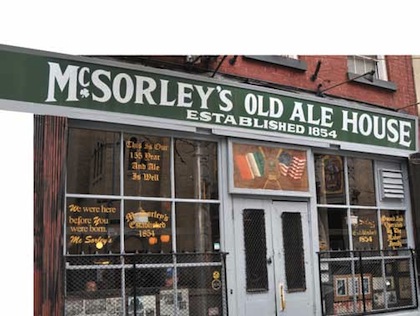You love beer. That’s a given. But how do you show beer you love it on a deeper level (besides reading a magazine that is all about it)? Whenever you travel, be it for a family vacation or a work trip, you always seek out local brewpubs. Maybe you’ve gone so far as to attend the Great American Beer Festival in Denver to explore tasty but short pours from coast to coast. You probably even have a beer kit you received as a gift because all your loved ones know you love beer. What next? Don’t just show your love, show your devotion.
Idaho farmers plant more than half a million acres of barley and wheat a year.
Last May, none other than homebrew guru and Brewers Association president Charlie Papazian led a retreat in Maine for a small but fervent group of beer nuts to learn more about the beverage we love and, well, get even nuttier. This year, he returned to his getaway off the coast of Maine, which he calls “Beer Island,” and went beyond the inaugural beercation’s four-day bonanza wherein he poured 88 beers of commercial creation and his own homebrew.

This led me to ask our beloved “CP” where else a devoted beer pilgrim can visit to soak up not just suds, but true beer culture. Among his recommendations were McSorley’s Old Ale House and the August Schell Brewing Co. for its 150th anniversary. Schell’s is celebrating this milestone all year long, but the real sesquicentennial festivities will be September 17th to the 18th, which, Papazian points out, is “unfortunately the same weekend as the Great American Beer Festival” in Denver. And since he is a co-founder of the GABF, it’s easy to predict which festival he’ll be at.
Going back to McSorley’s Old Ale House (15 East 7th St., New York, NY), it’s as fine a place as any to sit, drink and think about the storied history of ale in this great land. Founded by Irishman John McSorley in 1854, it is old without being among, say, the 10 oldest bars in the U.S. But McSorley’s Old Ale House is a throwback all the same. They boast that, “from Abe Lincoln to John Lennon [has] passed through McSorley’s swinging doors.” Pass through them yourself and the bartender will ask you, “Light or dark?” He’s not asking your general preference should your tastes lie above or below 20 on the 40-point Standard Reference Method (SRM) chart of beer coloration so as to steer you toward their selection of pale ales or porters. You literally have two choices, the light or the dark ale.
I shared a few glasses (they only serve mugs, not pints) with beer writer Peter LaFrance who had invited me to join him for a few rounds. The fact that he started writing about craft beer in 1984, some 20 years before me, is a testament to this gathering spot, with sawdust on the floor and dust cascading steadfastly from the bric-a-brac adorning the walls. Sure, there are beer bars more 20th or 21st century, but only cocky folks think they’re too good for the fundamentals.
And fundamentals are precisely why Papazian’s other recommendation, August Schell’s, is still in business. The August Schell Brewing Co. (1860 Schell Road, New Ulm, MN) is situated about 100 miles southwest of the Twin Cities. It is the second oldest family-run brewery after D.G. Yuengling & Son Brewing Co. (5th and Mahantongo Sts., Pottsville, PA, established in 1829). August’s great-great-grandson, Ted Marti (August’s daughter married George Marti) runs the show with help from his three sons.
I have made the pilgrimage to the brewery, where a muster of peacocks purportedly descended from the ones that August kept strut around the grounds; the same goes for the penned deer in the gardens. If you can’t make it to the 150th Anniversary this September, plan on going in February when the extremely Germanic town of New Ulm celebrates Fasching (German Mardi Gras) and Schell’s puts on its annual Bock Fest where they’ll stick a red-hot iron in your mug of bock to caramelize the sugars and keep you toasty.
There’s also the August Schell Museum of Brewing, but for a full-blown one, visit the National Brewery Museum (209 S. Main St., Potosi, WI). And what better location than in an actual former brewery? Naturally, expect the repurposed Potosi Brewery to house artifacts from its former brand, but the museum and research library aims to be a resource for historians, fans and avid collectors of breweriana―anything and everything to do with brewery collectibles from signs and trays to promotional fishing poles and neon lights.
The most enduring example of breweriana is the beer can itself. This year marks the 75th birthday of the vaunted vessel―the Gottfried Krueger Brewing Co. in New Jersey test-marketed the idea on Richmond, VA, shelves in 1935. As it begins its resurgence among craft brewers such as Oskar Blues and Surly, it is organizations such as the Brewery Collectibles Club of America (BCCA), American Breweriana Association (ABA) and the National Association of Breweriana Advertising (NABA) that are commemorating the lofty can’s diamond anniversary.
There’s more than one person who has turned his basement or old family room into a semi-public beer can museum, but only one who stores them on the outside. The Beer Can House (222 Malone St., Houston, TX) is where homeowner John Milkovisch adorned his house with over 50,000 cans starting in 1968.Today it is preserved by the Orange Show Center for Visionary Art. Tours are offered on weekends only.










If you’re at McSorley’s might check out Jimmy’s No 43 down the street on the same block. Great craft & farm to table spot.